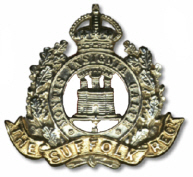



No.201357, Private, Frederick Sydney GRAY
Aged 30

|
Frederick Sydney GRAY was born in Burwell in 1887 (Newmarket Q2-1887 3B:535), son of John Richard and Susannah GRAY(née TWINN).
1891 census...Aged 4, he was at No 1, Railway Cottages, Stow cum Quy with his father John R GRAY [30] G.E.R. signalman born Cambridge; his mother Susannah [29] born Lark Hall, Cambs; brothers Charlie [6] born Burwell and Percy [1] born Stow cum Quy 1901 census...Aged 14, a farm labourer, he was at Railway Station, Stow cum Quy with his parents (father now Stationmaster; brothers Charlie (railway clerk), Percy and John R [2] born Quy and a lodger, Scots born William MacArthur [36] farm worker. 1911 census...Aged 24, a domestic gardener's labourer, he was still at the Railway Station, Stow cum Quy with his parents and brother John Richard The pension card has his family still at Quy Station, later moving to 68 Ditton Walk, Cambridge. |

|
He enlisted in Cambridge.
On the 11-12 October 1917 the battalion moved up from the Yser canal near Essex Farm to Rose Trench near Poelcapelle, marching in the pouring rain and being gas shelled on the way. Rose Trench was a water filled ditch and the troops spent the night in icy water up to their waists. Battalion HQ was in the remains of a building called Pheasant Farm and could only be entered by crawling on all fours. At about 5:30 on the 12th a British attack was launched and about an hour later the battalion moved forward following 55th Brigade, the right company going towards the left corner of Poelcapelle. A heavy enemy barrage met them as they went from Rose Trench to the Langemarck-Poelcapelle road. and after crossing the Dixmunde-Langemarck road they had to cope with heavy machine gun fire. The ground was so badly pock marked with shell holes filled with water that drowning was an ever present danger. That was a far as they got, being relieved the following day and having incurred over 230 casualties. Of these, 46 were killed, only 11 have identified graves. Frederick was found as shown below and identified by part of his AF64 (Army Form 64 - Active Service Pay Book) which had his earlier regimental number of 4098 still legible. He was then interred in Poelcapelle British Cemetery sometime in 1920.
click here to go to the Commonwealth War Graves Commission website for full cemetery/memorial details |